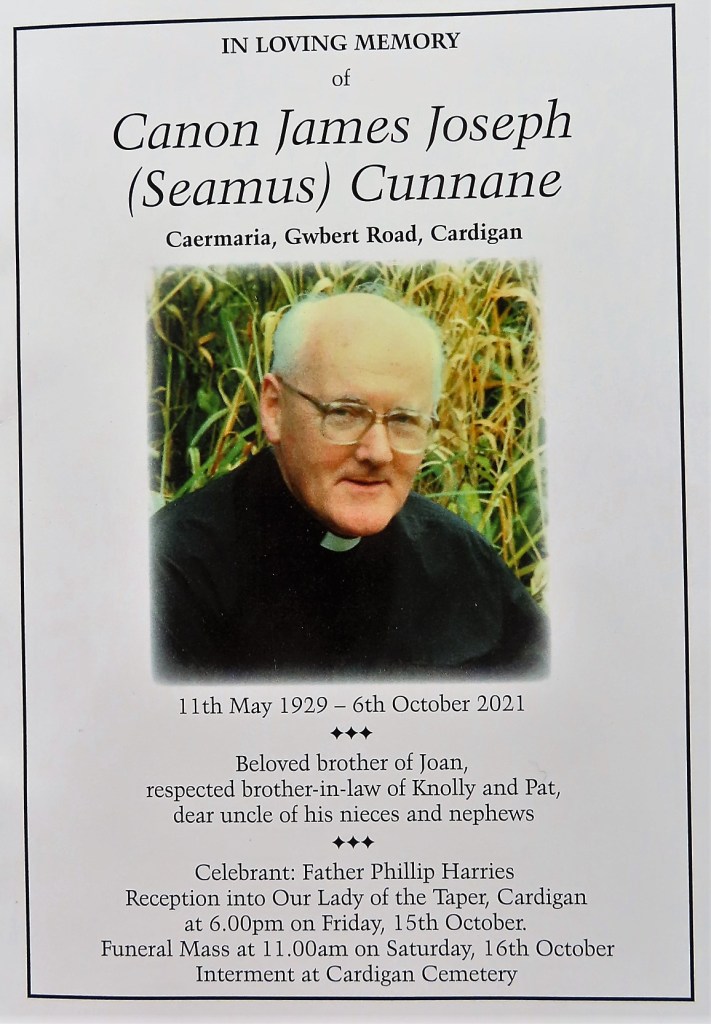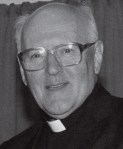Father Seamus Cunnane served as Cardigan’s Roman Catholic parish priest for 37 years from 1962 until 1999. His contribution to all aspects of life in Cardigan over the decades was considerable. The present Catholic church and its hall were built in the early 1970s and Fr Cunnane was closely involved in much of the fundraising for the project. His lifelong dedication to the Catholic Church will, no doubt, be discussed elsewhere.
As a keen local historian, Fr Cunnane extensively researched the history of Cardigan and its castle and it is worth focusing on his pioneering role in revealing Cardigan’s medieval past. His knowledge of Latin and his fluency in Welsh allowed him to research original sources. This was crucial to him. Never rely on secondary sources! Once he discovered the facts it was important that the truth was clearly articulated. He never minced his words.
As far back as 1992 he wrote: “For over 10 years I have taught local history and I do not want my work undone by inaccurate captions and descriptions that will doubtless be copied by schoolchildren and others.”
He had a dim view of Emily Pritchard’s, Cardigan Priory in the Olden Days, 1904.
“This was taken apart in 1905 when a reviewer commented: ‘The opening words of the first chapter are at once an indication of the author’s unfitness for her task.’
The trouble is that reviews disappear while the book remains and continues to mislead.”
He wrote a number of groundbreaking articles on medieval Cardigan including:
‘Ceredigion and the Old Faith’, Ceredigion, vol 12, 2, 1994, 3-34
‘The Topography of Mediaeval Cardigan’ in Carmarthenshire and Beyond: Studies in History and Archaeology in memory of Terry James, ed. Heather James and Patricia Moore, 2009, 204-23
He was also the author of:
Our Lady of Cardigan: a history and memoir, E. L. Jones, 2006, 56pp.
He enjoyed writing and arguing his case in the Tivy-side over the years, often disagreeing with published accounts of Cardigan history regardless of whether they were written by lay or academic historians.
The following is a list of some his letters and articles with comments:
‘The Four Gates’
The story behind Cardigan’s Teifi Gate; Wolf Gate; Bartholomew Gate and New Gate
31 Dec 1982
‘Llywelyn ein llyw olaf’
Llywelyn’s contact with Cardigan
December 1982
‘Pride of the Town’
It was time to make the Castle the pride of the town.
29 July 1983
- ‘It is likely that … (Gilbert de Clare) founded the Benedictine priory and St Mary’s Church…’ He certainly didn’t.
- ‘In 1165 the Welsh under Rhys ap Gruffudd expelled the English monks from their priory…’ No evidence (apart from Emily Pritchard’s book).
- ‘burgage figure of 172 in 1308’. The figure of 172 is suspect.
- ‘Here also (near College Row) was the North Gate … standing in 1843.’
A misunderstanding of W. E. James’s Guide Book (1899) where he is referring to the turnpike gate at the top of Pendre. - Town walls: ‘At the corner of College Row and Queen’s Tce the wall turned south along the Mwldan’. Not quite.
- On St Mary’s St he is absolutely wrong.
- On Chancery Lane he is even more grievously in error.
A review of The Towns of Medieval Wales, Ian Soulsby, 1983:
After some introductory words of praise he states that in relation to the part on Cardigan, “the book contains serious errors because [the author] relies on articles and books, some of which are wrong, instead of going to the primary sources. Twice he misunderstands the sources he uses and thus invents new errors.”
His conclusion: “in a future edition rewrite the Cardigan section.”
29 July 1983
‘Throwing new light on the history of Cardigan.’
In answer to the Revd D J Roberts’ queries in his weekly articles in the Tivy-side concerning the town’s history, he explains the origins of Mwldan, Pendre, Bartholomew Gate and Wolf Gate.
15 February 1985
‘Henry Tudor’s march through Cardigan 500 years ago’
A detailed description of life in Cardigan on Henry Tudor’s visit.
9 August 1985
‘In defence of Welsh history’
He writes: “Today you published an article on the medieval history of Cardigan and its castle called ‘The lock and stay of all Wales’ on a page carrying the rather incrongruous title ‘News Extra’. Much of it was indeed news to me, but only in the sense that it is demonstrably untrue.”
He restricts his comments to twelve headings and ends: “It is time to show respect for fact, and it is a pity that the Tivy-side showed such little regard for it…”
1 June 1990
‘The Mystery of Dydd Iau Mawr (Great Thursday) celebration at Aber-porth.’
The Thursday before 15th August – a Catholic celebration of Gŵyl Fair Gyntaf
9 August 1991
‘Statue not an idol and not adored’
Fr Cunnane disagreed with a caption written in the Time Tunnel exhibition where reference was made to ‘the existence of the idol: The Lady of the Taper’. His comment: “That is an untruth. The statue was not an idol and was not adored.”
4 September 1992
‘The day they hanged the vicar’
An account of the trial of Sir Hugh David Coch, vicar of Llanarth, and his subsequent fate in being hung, drawn and quartered on Banc y Warren in 1592.
28 May 1993
‘Cardigan development plan good news but…’
He writes: “We do not want hamfisted ‘development’ that ruins our heritage”
(and goes on to explain the origin of the name Chancery Lane or Suitor’s Lane)
21 July 1994
‘Monks arrived via Cardi Bach’
He corrects a few inaccuracies in a recent television programme concerning the Benedictine monks at Noyaddwilym and writes:
“Many locals did not like them, including the Tivy-side editor and several correspondents, but we must not tar everyone with the same brush.”
5 July 1996
‘Don’t dump part of our town’s history’
He writes: “Ceredigion wants to dump responsibility for a road named Bingham Lane. But there is no such place. Its name is Feidrfair … [and it is part] of the great medieval pilgrim route from Bardsey Island to St David’s.
Ceredigion [County Council] should publicise and enhance it. Instead it is ducking responsibility and some of us think this is shameful.”
27 November 2012
A few years back I attended a lecture by Prof Ralph Griffiths at the Catholic Hall under the auspices of Ceredigion History Society. His account of Medieval Cardigan in the broader regional context was enlightening but in the post lecture questions it was clear who knew most about Cardigan. On the way out someone turned to me and said “I don’t think they chose the right person to give that talk today.”
But he was not in any way stuck in the Middle Ages. Recent research into the swinging sixties in Cardigan revealed that he was proud to shake the hand of Screaming Lord Sutch during his infamous visit to the town to perform at the Black Lion in April 1964.
The complete story of early Cardigan remains to be told, but Fr Cunnane has set a firm foundation for future historians.
RIP Seamus Cunnane.




One thought on “Cardigan People 54: Seamus Cunnane (1929-2021)”